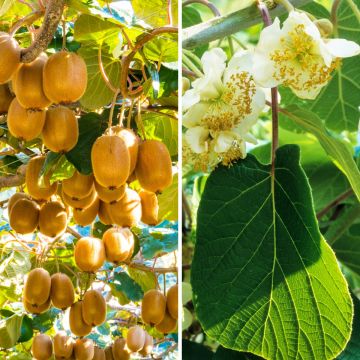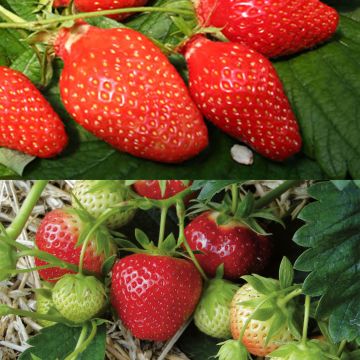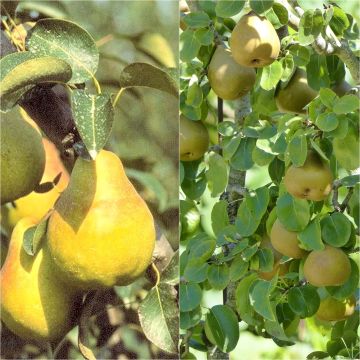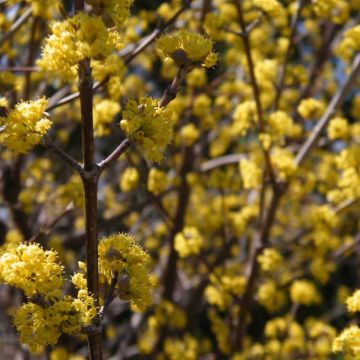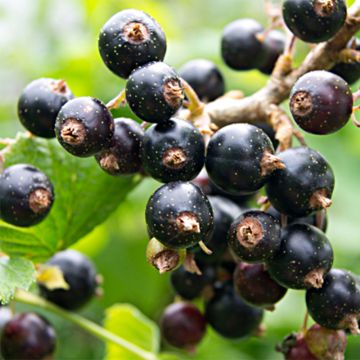Shipping country and language
Your country of residence may be:
Your country of residence is:
For a better user experience on our website, you can select:
Your shipping country:
Andorra
Austria
Belgium
Bulgaria
Canada
Chile
Croatia
Cyprus
Czechia
Denmark
Estonia
Finland
France
Germany
Greece
Hungary
Iceland
Ireland
Italy
Latvia
Lithuania
Luxembourg
Malta
Monaco
Netherlands
Poland
Portugal
Romania
Slovakia
Slovenia
Spain
Sweden
Switzerland
United Kingdom
We only deliver seed and bulb products to your country. If you add other products to your basket, they cannot be shipped.
Language:
French
German
Spanish
English
My Account
Hello
My wish lists
Plantfit
Log in / Register
Existing customer?
New customer?
Create an account to track your orders, access our customer service and, if you wish, make the most of our upcoming offers.


Pollinator duo for a bountiful harvest of hazelnuts
Pollinator duo for a bountiful harvest of hazelnuts
Corylus avellana Fertile de Coutard, Merveille de Bollwiller
Noisetier commun - Coudrier
Parfait dans l ensemble .Manque l étiquetage sur certains plants . Plants qui ont l'air vigoureux
Antoine, 27/01/2024
Order in the next for dispatch today!
Dispatch by letter from €3.90.
Delivery charge from €5.90 Oversize package delivery charge from €6.90.
More information
This item is not available in your country.
Schedule delivery date,
and select date in basket
This plant carries a 6 months recovery warranty
More information
We guarantee the quality of our plants for a full growing cycle, and will replace at our expense any plant that fails to recover under normal climatic and planting conditions.
From €5.90 for pickup delivery and €6.90 for home delivery
Express home delivery from €8.90.
Collection items (0 plants)
Description
This pair of hazelnut trees brings together two excellent varieties, renowned for their earliness and the quality of their hazelnuts. They will pollinate each other, resulting in a more abundant harvest in August-September. Hazelnut trees are very resistant bushes, not demanding in terms of soil and climate, and can be grown anywhere in Central Europe. They thrive equally well in shrub beds or in free hedges. Preferably plant them in autumn.
The pair consists of:
- x1 'Coutard's Fertile' Hazelnut Tree: a vigorous variety that bears fruit quickly, quite hardy and productive. It produces some of the largest hazelnuts in Europe. They are round, with ivory-white, firm flesh and a pleasant fragrance. Early but susceptible to frost, it is ideal to orient it to the north to delay flowering. This old Spanish variety has been cultivated in France since at least 1721, with the earliest recorded traces in literature.
- x1 'Bollwiller's Wonder' Hazelnut Tree: an early hazelnut variety that produces medium to large-sized nuts, elongated in shape with a well-filled shell. You can harvest the fruits from mid-August. This bush's production is regular and abundant.
In separate 4/5-liter pots, labeled separately.
The hazelnut tree, in Latin Corylus avellana, formerly known as the coudrier, belongs to the Betulaceae family. It is found naturally throughout Europe except in excessively dry and hot areas in the south, where it has become rare. With a slightly suckering stump, it produces 10 to 12 slender trunks and grows into a bushy clump that can reach up to 5 m (16ft) in height and 3 m (10ft) in width. Its brown bark can peel off in thin flakes. Its heart-shaped leaves are toothed with a pointed tip. The foliage is deciduous, falling in autumn. Monoecious, the hazelnut tree produces male flowers, yellowish, grouped in 6 cm (2in) catkins, and female flowers, very condensed, in erect spikes with red styles. The male catkins appear from the beginning of summer, blooming from mid-December to early March on bare branches, while the female flowers bloom in March-April, a few weeks after the male flowers. Their pollination is ensured by the wind.
Hazelnuts are generally grouped in small clusters of two or three fruits. Just before the fruit ripens, the shell appears. It hardens and changes color, while the kernel concentrates sugars, oil, and minerals. This ripening occurs in autumn, and harvesting takes place at the end of August and in September, when the hazelnuts easily detach from the branches.
Hazelnuts are consumed as dried fruits. They are also used in pastries and confectionery: grated into powder, crushed, roasted, or sliced into flakes. They are also used to extract oil, although it is prone to rancidity. This fruit is rich in omega-9, vitamin E, and vitamin B.
Spot the hazelnuts before the squirrel that frequents your garden does! It loves them! In a large free hedge, hazelnut trees can be paired with numerous shrubs such as European spindle trees, blackthorns, wild cherries, ornamental apple trees, male dogwoods, or serviceberries.
Plant habit
Fruit
Flowering
Foliage
Botanical data
Corylus
avellana
Fertile de Coutard, Merveille de Bollwiller
Betulaceae
Noisetier commun - Coudrier
Cultivar or hybrid
Other Our fruit tree and berry bush collection
Planting and care
Carry out the planting of the Hazelnut bush during the frost-free period, preferably in autumn. If your soil is very clayey, balance it with a little compost and gravel. Dig a hole 50 to 60 cm (20 to 24in) deep and wide. Fill half of this hole with soil enriched with compost and planting soil. Install the hazelnut bush with the collar at ground level (which corresponds approximately to the start of the first branches), then fill the planting hole with the remaining soil. Firmly press around the base of the bush to form a basin and water abundantly (10 to 15 liters of water) so that the roots are in good contact with the soil.
The hazelnut bush is not demanding in terms of soil, it will grow well in any sufficiently deep and loose soil. It tolerates limestone well, as well as slightly acidic soils. Once well rooted, it no longer needs watering in summer. Very hardy, this bush can withstand temperatures as low as -20°C (1°F).
The main enemy of the hazelnut bush is the Hazelnut Weevil, a small beetle whose female lays eggs in the young hazelnuts in early summer. To limit damage, you can place prevention glue bands at the base of the stems in early spring: this prevents adult females from climbing into the branches to lay eggs. In winter, work the soil around the hazelnut bushes to expose the larvae: they will be consumed by chickens or insectivorous birds. Also, remember to collect and burn affected fruits that fall prematurely.
Planting period
Intended location
Care
- , onOrder confirmed
Reply from on Promesse de fleurs
Easy-grow fruit trees
Haven't found what you were looking for?
Hardiness is the lowest winter temperature a plant can endure without suffering serious damage or even dying. However, hardiness is affected by location (a sheltered area, such as a patio), protection (winter cover) and soil type (hardiness is improved by well-drained soil).

Photo Sharing Terms & Conditions
In order to encourage gardeners to interact and share their experiences, Promesse de fleurs offers various media enabling content to be uploaded onto its Site - in particular via the ‘Photo sharing’ module.
The User agrees to refrain from:
- Posting any content that is illegal, prejudicial, insulting, racist, inciteful to hatred, revisionist, contrary to public decency, that infringes on privacy or on the privacy rights of third parties, in particular the publicity rights of persons and goods, intellectual property rights, or the right to privacy.
- Submitting content on behalf of a third party;
- Impersonate the identity of a third party and/or publish any personal information about a third party;
In general, the User undertakes to refrain from any unethical behaviour.
All Content (in particular text, comments, files, images, photos, videos, creative works, etc.), which may be subject to property or intellectual property rights, image or other private rights, shall remain the property of the User, subject to the limited rights granted by the terms of the licence granted by Promesse de fleurs as stated below. Users are at liberty to publish or not to publish such Content on the Site, notably via the ‘Photo Sharing’ facility, and accept that this Content shall be made public and freely accessible, notably on the Internet.
Users further acknowledge, undertake to have ,and guarantee that they hold all necessary rights and permissions to publish such material on the Site, in particular with regard to the legislation in force pertaining to any privacy, property, intellectual property, image, or contractual rights, or rights of any other nature. By publishing such Content on the Site, Users acknowledge accepting full liability as publishers of the Content within the meaning of the law, and grant Promesse de fleurs, free of charge, an inclusive, worldwide licence for the said Content for the entire duration of its publication, including all reproduction, representation, up/downloading, displaying, performing, transmission, and storage rights.
Users also grant permission for their name to be linked to the Content and accept that this link may not always be made available.
By engaging in posting material, Users consent to their Content becoming automatically accessible on the Internet, in particular on other sites and/or blogs and/or web pages of the Promesse de fleurs site, including in particular social pages and the Promesse de fleurs catalogue.
Users may secure the removal of entrusted content free of charge by issuing a simple request via our contact form.
The flowering period indicated on our website applies to countries and regions located in USDA zone 8 (France, the United Kingdom, Ireland, the Netherlands, etc.)
It will vary according to where you live:
- In zones 9 to 10 (Italy, Spain, Greece, etc.), flowering will occur about 2 to 4 weeks earlier.
- In zones 6 to 7 (Germany, Poland, Slovenia, and lower mountainous regions), flowering will be delayed by 2 to 3 weeks.
- In zone 5 (Central Europe, Scandinavia), blooming will be delayed by 3 to 5 weeks.
In temperate climates, pruning of spring-flowering shrubs (forsythia, spireas, etc.) should be done just after flowering.
Pruning of summer-flowering shrubs (Indian Lilac, Perovskia, etc.) can be done in winter or spring.
In cold regions as well as with frost-sensitive plants, avoid pruning too early when severe frosts may still occur.
The planting period indicated on our website applies to countries and regions located in USDA zone 8 (France, United Kingdom, Ireland, Netherlands).
It will vary according to where you live:
- In Mediterranean zones (Marseille, Madrid, Milan, etc.), autumn and winter are the best planting periods.
- In continental zones (Strasbourg, Munich, Vienna, etc.), delay planting by 2 to 3 weeks in spring and bring it forward by 2 to 4 weeks in autumn.
- In mountainous regions (the Alps, Pyrenees, Carpathians, etc.), it is best to plant in late spring (May-June) or late summer (August-September).
The harvesting period indicated on our website applies to countries and regions in USDA zone 8 (France, England, Ireland, the Netherlands).
In colder areas (Scandinavia, Poland, Austria...) fruit and vegetable harvests are likely to be delayed by 3-4 weeks.
In warmer areas (Italy, Spain, Greece, etc.), harvesting will probably take place earlier, depending on weather conditions.
The sowing periods indicated on our website apply to countries and regions within USDA Zone 8 (France, UK, Ireland, Netherlands).
In colder areas (Scandinavia, Poland, Austria...), delay any outdoor sowing by 3-4 weeks, or sow under glass.
In warmer climes (Italy, Spain, Greece, etc.), bring outdoor sowing forward by a few weeks.

